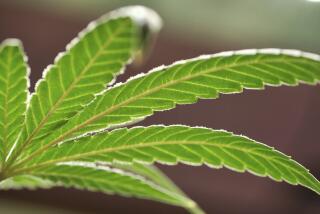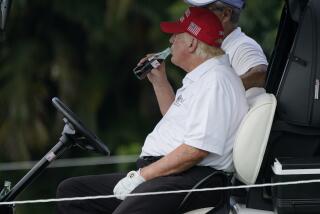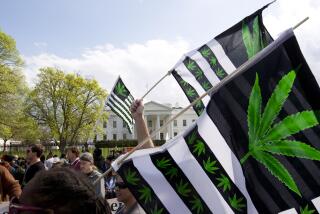Clinton Not to Blame for Rise in Teen Drug Use, Experts Say
WASHINGTON â Government studies have found that the use of illegal drugs, especially marijuana, has risen sharply in the past three years, an issue Republican presidential candidate Bob Dole has hammered at on the campaign trail.
But does Bill Clinton deserve the blame for increasing drug use among adolescents?
Most experts on drug abuse say he does not, although they agree that Clinton has failed to speak out against drug abuse with the same fervor he has directed against cigarettes.
âI think itâs a cheap shot and almost ludicrous to say kids are using drugs because of what the president did or didnât say,â said Eric Sterling, president of Criminal Justice Policy Foundation. âEverybody ought to be concerned about this steep and sudden rise [in drug use], but it doesnât make any more sense to blame this president than to blame Richard Nixon or Gerald Ford for the high level of drug abuse in the early 1970s.â
Added Mark Kleiman, a UCLA professor of public policy: âIf I knew why kids picked up one fad this year and dropped it the next, I wouldnât have to make a living teaching. I donât think itâs a matter of presidential leadership. If it were, then tobacco use by kids should be way down, because Clinton has been clear and bold on that subject.â
Most experts who track drug abuse point to âgenerational forgettingâ as the best explanation for the recent trend.
In 1979, slightly more than 16% of those who were ages 12 to 17 reported they had used an illegal drug in the previous month, when interviewed as part of the annual National Household Survey for the Department of Health and Human Services. By 1992, the percentage had fallen to a low of 5.3%.
Last year, the number had jumped to 10.9%, a doubling in three years, as Dole repeatedly has noted.
âThe standard explanation for this is that itâs been a long time since kids saw the really bad side of drug abuse among their friends and people they come into contact with. They donât know how dangerous it can be,â said Peter Reuter, a University of Maryland professor.
Still, he and others admit to being baffled by the cyclic nature of drug use. âThe truth is, we donât have a good basis for saying why this is happening. Marijuana use started falling in 1979, before anyone in Washington got interested in the problem, and it started going back up in 1992,â he said.
In speeches and television ads, however, Dole has not only voiced alarm at the rise in teen drug use but has also squarely put the blame on the Clinton administration.
âThanks to the liberal wink-and-nod policies of this administration, drug use among teenagers has not just started up but is rocketing skyward,â he told an audience in Philadelphia on Monday. âWhy? The fact is that the country is reaping the bitter harvest of what this administrationâs liberal policies have sowed.â
During his first year in office, Clinton sharply cut the staffing at the office that sets federal drug policy, Dole pointed out. Clinton subsequently restored the office to its previous staffing level and appointed retired Army Gen. Barry R. McCaffrey as its director earlier this year.
The president, Dole charged, âhas turned âJust Say Noâ [the anti-drug slogan during the Reagan administration] into âjust say nothing.â â
In ads that began running this week, the Dole campaign targets Clinton even more on the drug issue.
âUnder Clinton, cocaine and heroin use among teenagers has doubled. Why? Because Bill Clinton isnât protecting our children from drugs,â the announcer intones.
If elected, Dole has said, he would use the military in the fight to stop the flow of narcotics into the United States and aggressively prosecute all drug crimes.
âWhen Iâm president, I donât intend to wink at drugs. I intend to wipe them out,â Dole said.
Doleâs ads and speeches avoid pointing out that federal spending for the drug war has risen steadily during the Clinton years, from $12.2 billion in the 1993 federal fiscal year to a proposed $15.1 billion for the coming fiscal year, which begins Oct. 1.
In addition, while the Republican challenger has correctly highlighted the recent trend in teenage drug use, his use of percentages may exaggerate the problem, some experts said.
âThey are talking about cocaine use âdoubling,â but it doesnât sound as extreme if you say that 8 in 1,000 are using it, up from 3 per 1,000,â said John P. Morgan, a pharmacologist and drug expert at the City University of New York Medical School.
The Clinton campaign, in its own ads firing back at Dole, points to the fact that as a senator, Dole voted against the creation of a âdrug czar,â who heads the same White House-based office he now blames Clinton for underfunding. The ad also notes that Republicans in Congress voted to cut federal funds for anti-drug education programs in schools.
While many drug experts doubt Clintonâs low-key approach to drugs explains the recent trend among teenagers, most also say the president should have spoken out more against drug abuse.
âClinton could have addressed this issue more forcefully,â said Peter H. Smith, a political science professor at UC San Diego. âNot to be alarmist or to portray drug users as evil people. But drug consumption is dangerous. It is costly to American society. He should have said the same things he says about cigarette smoking. But my sense is they would just like this issue to go away.â
John Walters, the last drug czar under President Bush, said Clinton should have directly confronted the baby boom generationâs experience with drugs.
âHe should have said, âYes, my generation experimented with drugs, and it was a mistake and hereâs why.â But he has failed to articulate a serious message. Itâs a lack of moral leadership,â said Walters.
Others said not just politicians but also parents and educators have failed to explain to adolescents why they should stay away from marijuana.
âKids who are 14 or 15 react against the âJust Say Noâ message because it is too simple,â said Sterling. âOnce they see that Jimmy has smoked marijuana and he seems to do OK in class or on the football field, they get the message that it is no problem. But like alcohol, heavy use [of marijuana] destroys your brain and ruins your lungs.â
The dire warnings to young people about the hazards of narcotics sometimes backfire, Reuter said, because marijuana is included.
âThere are a large number of very dangerous drugs out there, but if you ask how dangerous is marijuana if used occasionally, the answer is, âNot very,â â he said. âIt probably undermines the credibility of our prevention programsâ to lump marijuana together with drugs such as cocaine and heroin, he said.
Veteran combatants in the war on drugs said they fear the nation may be in the opening stage of another cycle of increasing drug abuse, particularly if Clinton does not do more to highlight the issue.
âI predict use and abuse will continue to rise markedly again until kids see the casualties,â said Herbert Kleber, vice president and research director at the National Center on Addictions and Substance Abuse in New York. âOnly then will the numbers start to go down again. But it would be nice if we didnât have to go through this cycle again to relearn the lesson.â
âI donât think itâs a matter of presidential leadership. If it were, then tobacco use by kids should be way down.â
(BEGIN TEXT OF INFOBOX / INFOGRAPHIC)
Drug Use Over the Years
The peak year of use of any illict drug was 1979, according to federal figures. Since then reported drug usage has shown a general pattern of decline among Americans of various ages and ethnic groups. But drug usage among 12-17 year olds has recently begun to show an increase.
*--*
AGE GROUP 1979 1985 1990 1995 12-17 16.3% 13.2% 7.1% 10.9% 18-25 38.0% 25.3% 15.0% 14.2% 26-34 20.8% 23.1% 10.9% 8.3% Over 35 2.8% 3.9% 3.1% 2.8% RACE/ETHNICITY White 14.2% 12.3% 6.9% 6.0% Black 13.3% 12.7% 7.3% 7.9% Hispanic 12.9% 8.9% 5.6% 5.1% Other 15.1% 10.7% 3.4% 4.0%
*--*
Source: Department of Health and Human Services
More to Read
Get the L.A. Times Politics newsletter
Deeply reported insights into legislation, politics and policy from Sacramento, Washington and beyond. In your inbox three times per week.
You may occasionally receive promotional content from the Los Angeles Times.











